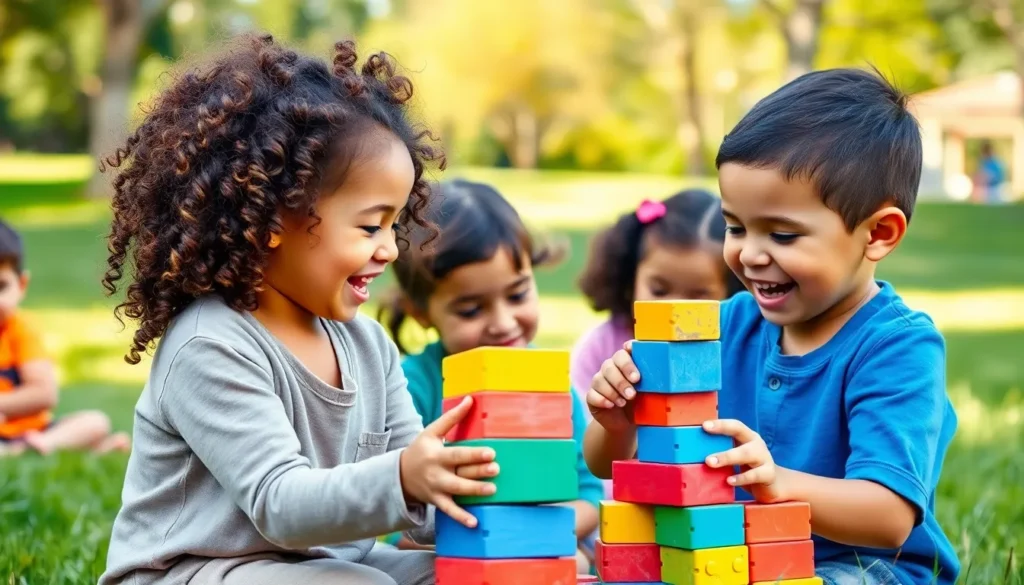In today’s fast-paced world, the concept of learning through play has gained significant traction. This approach emphasizes the importance of play as a vital component of childhood development, allowing children to explore, experiment, and engage with their environment in meaningful ways. By integrating play into learning, kids not only absorb knowledge but also develop essential social, emotional, and cognitive skills.
Research shows that play-based learning fosters creativity and critical thinking, making it a powerful tool for educators and parents alike. As children navigate various play scenarios, they learn to solve problems and collaborate with peers, setting the stage for lifelong learning. Embracing this method can transform traditional educational practices, creating a more dynamic and enjoyable learning experience.
Table of Contents
ToggleWhat Is Learning Through Play?
Learning through play involves children engaging in activities that promote cognitive, social, and emotional development. This approach emphasizes that play is not merely recreational; it’s a fundamental component of effective learning.
Definition and Concept
Learning through play refers to a method where children gain knowledge and skills through interactive and engaging activities. These activities often incorporate imagination, exploration, and hands-on experiences. According to the National Association for the Education of Young Children (NAEYC), play enables children to experiment, discover new ideas, and express themselves. This method encourages problem-solving, creativity, and collaboration, fostering an enriching environment for holistic development.
Historical Background
The concept of learning through play dates back to ancient philosophies, with roots in the works of Plato and Aristotle, who recognized the significance of play in education. In the 19th century, Friedrich Froebel introduced the idea of “kindergarten,” emphasizing play as essential for early childhood development. His theories influenced educational practices, recognizing playtime as critical for social interactions and cognitive growth. By the 20th century, scholars like Jean Piaget and Lev Vygotsky further established the foundational role of play, integrating it into modern educational frameworks. Today, educational institutions widely adopt play-based learning methodologies, aligning with contemporary insights into child development.
Benefits of Learning Through Play

Learning through play offers numerous advantages for overall development. It fosters interactive environments where children can thrive, enhancing cognitive, social, and emotional growth.
Cognitive Development
Cognitive development flourishes through play activities that challenge children’s problem-solving abilities. Engaging in games stimulates critical thinking, allowing them to understand concepts such as numbers, shapes, and patterns. Play also enhances memory and attention span. For instance, children participating in role-play can develop narrative skills and improve language proficiency. Research indicates that play-based learning can lead to higher academic achievement, often resulting in improved scores in subjects like math and reading.
Social and Emotional Skills
Social and emotional skills develop significantly through play interactions. Collaboration fosters teamwork, helping children learn to negotiate and share. They practice empathy by understanding others’ feelings and perspectives during group games. For example, turn-taking activities teach patience and respect for others. Furthermore, play allows children to express their emotions safely, enhancing self-regulation. According to studies, children who engage in play-based learning exhibit better social skills, often leading to healthier relationships with peers and adults alike.
Different Approaches to Learning Through Play
Learning through play encompasses various approaches, including structured and unstructured play. Each method offers unique benefits that enhance children’s developmental experiences.
Structured Play
Structured play involves organized activities with specific goals and rules, often guided by an adult. Examples include group games, educational workshops, and teacher-led activities. This approach encourages cognitive development by promoting critical thinking and decision-making skills.
Structured play sessions typically focus on certain objectives, such as arithmetic skills or language acquisition. Research shows that children participating in structured play settings often exhibit improved concentration and a higher level of engagement. They learn to follow instructions, collaborate with peers, and develop discipline, which contributes positively to their overall educational journey.
Unstructured Play
Unstructured play refers to free, spontaneous play where children choose their activities without adult intervention. Examples include exploring a playground, engaging in imaginative role play, or simply manipulating toys. This type of play fosters creativity and self-expression, allowing children to explore their interests and preferences.
Unstructured play enhances problem-solving skills, as children navigate challenges independently. Studies indicate that children engaged in unstructured play develop better emotional intelligence and social skills. They learn to resolve conflicts, negotiate roles, and experience frustration and joy, all of which contribute to their emotional resilience.
Implementing Learning Through Play in Education
Integrating learning through play in educational settings creates engaging environments that stimulate development. Practical strategies enhance children’s experiences and empower educators.
Classroom Strategies
- Incorporate Play-Based Activities: Use games and hands-on activities to teach concepts in subjects like math and literacy. Activities such as counting games and storytelling enhance learning engagement.
- Create Learning Centers: Establish designated areas for different types of play, including art, puzzles, and construction. These centers encourage exploration and foster independent learning.
- Use Interactive Storytelling: Incorporate storytelling sessions that involve participation. Engaging students in dialogues promotes language development and critical thinking.
- Facilitate Collaborative Projects: Organize group projects where children collaborate to solve problems. Such collaboration builds social skills and fosters teamwork.
- Embrace Outdoor Play: Utilize outdoor spaces for structured and unstructured play. Nature-based activities improve motor skills and offer a natural learning platform.
Role of Educators
- Guide Play Experiences: Educators should facilitate and support play experiences rather than direct them. Providing guidance when necessary encourages creativity while ensuring learning goals remain clear.
- Observe and Assess: Regularly observe children’s play to assess developmental progress. Evaluate skills demonstrated during play to inform teaching strategies.
- Build Partnerships: Collaborate with parents to reinforce learning through play at home. Sharing resources and ideas enhances the effectiveness of play-based learning.
- Adapt Learning Objectives: Tailor learning objectives to incorporate play. Flexibility in objectives allows for a more personalized educational experience that meets children’s needs and interests.
- Model Positive Interactions: Demonstrate patience and effective communication skills. Modeling these behaviors encourages children to replicate them during interactions with peers.
Challenges and Considerations
Learning through play presents several challenges and considerations which educators and parents must address for effective implementation. Understanding these factors enhances the educational experience.
Balancing Play and Curriculum
Balancing play and curriculum requires intentional planning. Educators must integrate play-based activities with academic learning objectives. For example, incorporating math games within play scenarios ensures that children engage with numbers while enjoying the activity. While play fosters creativity and exploration, it’s crucial to maintain alignment with established learning standards. Educators must regularly assess the effectiveness of these activities and adapt them as necessary. Collaboration among teachers can facilitate the development of a cohesive curriculum that values play, ensures compliance with educational requirements, and meets developmental milestones.
Parental Involvement
Parental involvement plays a vital role in the success of learning through play. Parents can support play-based learning by creating enriching home environments that promote exploration and creativity. For instance, providing access to varying materials like building blocks, art supplies, and outdoor toys encourages children to engage in constructive play. Moreover, maintaining regular communication between educators and parents enhances understanding of learning objectives and fosters consistency in reinforcing concepts learned at school. Workshops and resources can equip parents with strategies to facilitate meaningful play at home, bridging the gap between educational settings and family life.
Embracing learning through play transforms the educational landscape for children. It cultivates essential skills that extend beyond the classroom and fosters a love for learning. By integrating play into educational practices educators and parents can create a rich environment that nurtures creativity and critical thinking.
The benefits are clear as children develop socially emotionally and cognitively through meaningful play experiences. As the understanding of play’s role in development continues to grow it’s vital for educators and parents to collaborate in supporting this approach.
Ultimately learning through play not only enhances academic success but also prepares children for a future where adaptability and problem-solving are key. This holistic approach to learning ensures that children thrive both in their education and in life.







